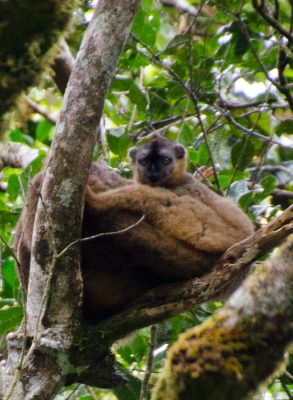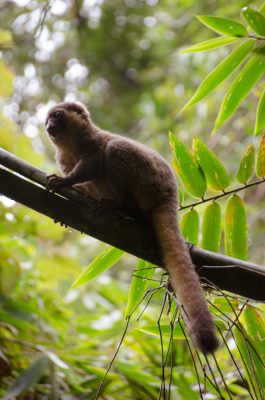While visiting Ranomafana National Park, I stayed at Centre ValBio so I could get a first hand look at the Center, learn about their work, and chat with the staff. Stay tuned to the LCN blog for an interview with Pascal Robeson, Centre ValBio’s Madagascar Country Director, and a post about CVB’s truly inspiring work.
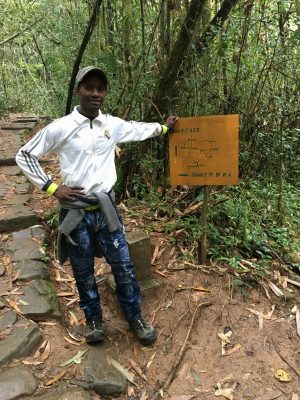
Hiking with my Guide Théo
Théo is the favorite guide for many at CVB. Pat Wright hires him often, and he was David Attenborough’s guide for the BBC Madagascar series several years back. Théo traveled the whole island with Attenborough, and came home a local celebrity. Attenborough even checks in with him periodically via email.
Théo is an expert. He grew up learning every bird and lemur’s calls to make it easier to hunt them with a slingshot. Now a hunter turned tour guide, he uses these same calls to help tourists spot them.
Motionless, Théo listens closely for slight movements and any hint that wildlife is nearby. With Théo in a National Geographic “Bird Nerd” vest (given to him by Attenborough) and me being a solo traveler, the other travelers in Ranomafana seemed to think I must be someone really important to get this key tracker all to myself. Ha!
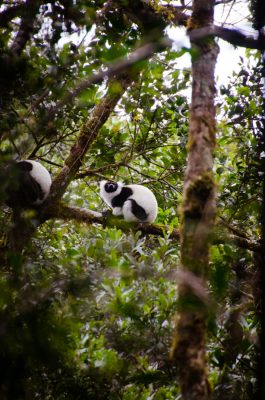
Théo likes is often the first to spot a group of lemurs with his expert tracking skills.
When I’m lucky, I get to see the lemurs as the only tourist in the area! Climbing deep into the forest to get closer, I follow the trackers to two black and white ruffed lemurs chowing down on leaves high in the canopy. We stay awhile, grasping branches to remain upright and looking ever upwards at these marvels of nature. Other groups of tourists eventually join us after their guides got word of our lemur sighting. Most are content to view them from the comfort of the trail. Eventually I climb out of the dense forest to see a group of onlookers.
Théo urges me to move on to give them viewing space and so we can try to find Milne Edwards Sifakas. Goodbye, black and white ruffed lemurs! According to Théo, I’ll see them again in Kianjavato (my next stop on my trip) so I wave goodbye and we continue.
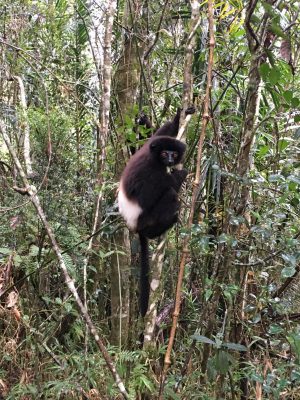
We had seen a group of sleeping Milne Edwards Sifakas yesterday. I was hoping for another sighting!
These guys are seriously adorable, and my backlit sleepy sifaka pictures didn’t turn out so great. But Théo had said we were lucky to spot them at all, so I had properly tempered my expectations.
Then suddenly out of nowhere, Théo could hear a whole group of them traveling! We walked just five feet off the trail and stood within two arms reach of a family of Milne Edwards Sifakas as they leapt past. Two of them had little babies holding on to their mothers’ backs — what an amazing sight! We got so close I could even take clear pictures and video with my cell phone. It was stunning to be in the company of such beauty in their natural environment.
By the time the other tourists showed up after their guides heard about our spotting, the lemurs had leaped away through the forest. We were truly lucky to be in the right place at exactly the right time. What a surprise!
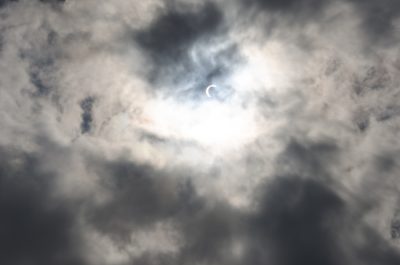
Would we see the eclipse?
It was a full and rewarding day as we walked toward the village of Ranomafana in the afternoon. Today, there would be an eclipse in Madagascar, and we didn’t know what to expect. We weren’t right in the direct path, but we wondered, would it get dark? Would the animals do anything unusual? We kept walking down the mountain, out of the thick forest, and towards a beautiful waterfall view, waiting for the eclipse.
We stop at the waterfall for a snack and see the sun as it is partially eclipsed. It didn’t get dark at all and animals and birds didn’t seem to notice! A little disappointing, but after such great sightings earlier in the day, I couldn’t complain.
My Travel Details
- Driver: Zina, booked through Asisten Travel
- Guide in Ranomafana: Théo
- Where I Stayed in Ranomafana: I stayed in the dorms at Centre ValBio, which is typically reserved for researchers or those affiliated with the Centre.
- Cost to Visit Ranomafana National Park: ~50,000 ariary per day entrance fee plus guide fee and tip. A Malagasy group also collects ~3,000 to give to the locals who were displaced by the park.
How To Help
